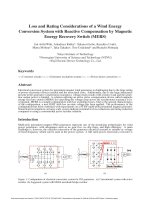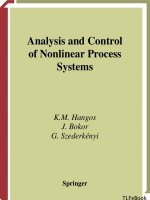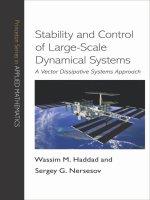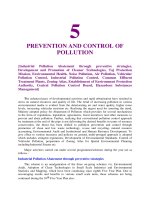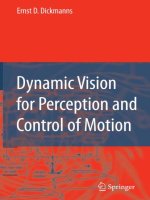Dynamic Model and Control of DFIG Wind Energy Systems Based on Power Transfer Matrix
Bạn đang xem bản rút gọn của tài liệu. Xem và tải ngay bản đầy đủ của tài liệu tại đây (392.23 KB, 9 trang )
IEEE TRANSACTIONS ON POWER DELIVERY, VOL. 27, NO. 3, JULY 2012 1485
Dynamic Model and Control of DFIG Wind Energy
Systems Based on Power Transfer Matrix
Esmaeil Rezaei, Ahmadreza Tabesh, Member, IEEE, and Mohammad Ebrahimi
Abstract—This paper presents a power transfer matrix model
and multivariable control method for a doubly-fed induction
generator (DFIG) wind energy system. The power transfer matrix
model uses instantaneous real/reactive power components as the
system state variables. It is shown that using the power transfer
matrix model improves the robustness of controllers as the power
waveforms are independent of a
frame of reference. The
sequential loop closing technique is used to design the controllers
based on the linearized model of the wind energy system. The
designed controller includes six compensators for capturing the
maximum wind power and supplying the required reactive power
to the DFIG. A power/current limiting scheme is also presented
to protect power converters during a fault. The validity and per-
formance of the proposed modeling and control approaches are
investigated using a study system consisting of a grid-connected
DFIG wind energy conversion system. This investigation uses
the time-domain simulation of the study system to: 1) validate
the presented model and its assumptions, 2) show the tracking
and disturbance rejection capabilities of the designed control
system, and 3) test the robustness of the designed controller to the
uncertainties of the model parameters.
Index Terms—Doubly fed induction generator (DFIG), dy-
namics modeling, instantaneous power, multivariable control,
wind energy systems, wind power control, wind turbine generator.
I. INTRODUCTION
W
IND ENERGY conversion systems are currently
among economically available and viable renewable
energy systems which have experienced rapid growth in recent
years. Increasing the penetration level of wind farms highlights
the grid integration concerns including power systems stability,
power quality (PQ), protection, and dynamic interactions of
the wind power units in a wind farm [1]–[3]. Wind energy
systems based on doubly fed induction generators (DFIGs)
have been dominantly used in high-power applications since
they use power-electronic converters with ratings less than the
rating of the wind turbine generators [4]–[8]. The scope of this
paper is dynamic modelling and control of DFIG wind turbine
generators.
Modeling and control of DFIGs have been widely investi-
gated based on well-established vector control schemes in a
Manuscript received July 31, 2011; revised April 02, 2012; accepted April
13, 2012. Date of publication May 30, 2012; date of current version June 20,
2012. Paper no. TPWRD-00653-2011.
The authors are with the Department of Electrical and Computer Engineering,
Isfahan University of Technology, Isfahan 84156, Iran (e-mail: rezaei58@ec.
iut.ac.ir; ; ).
Digital Object Identifier 10.1109/TPWRD.2012.2195685
stator field-oriented frame of reference [7]–[9]. The vector con-
trol is a fast method for independent control of the real/reactive
power of a machine. The method is established based on con-
trol of current components in a
frame of reference using an
transformation. Since the components are not phys-
ically available, the calculation of these components requires a
phase-locked loop (PLL) to determine synchronous angle [10],
[11]. The dynamics of
transformations are often ig-
nored in the procedure of control design. Thus, any control de-
sign approach must be adequately robust to overcome the un-
certainties in estimation of machine parameters as well as un-
accounted dynamics of the overall system. The proposed power
transfer matrix model for DFIG in this paper presents an alter-
native modeling and control approach which is independent of
transformations.
Direct torque control (DTC) and direct power control
schemes (DPC) have been presented as alternative methods
which directly control machine flux and torque via the selection
of suitable voltage vectors [12]–[14]. It has been shown that
DPC is a more efficient approach compared to modified DTC
[15]–[17]. However, the DPC method also depends on the
estimation of machine parameters and it requires a protection
mechanism to avoid overcurrent during a fault in the system.
This paper presents a modelling and control approach which
uses instantaneous real and reactive power instead of
compo-
nents of currents in a vector control scheme. The main features
of the proposed model compared to conventional models in the
frame of reference are as follows.
1) Robustness: The waveforms of power components are in-
dependent of a reference frame; therefore, this approach
is inherently robust against unaccounted dynamics such as
PLL.
2) Simplicity of realization: The power components (state
variables of a feedback control loop) can be directly ob-
tained from
phase voltage/current quantities, which
simplifies the implementation of the control system.
Using power components instead of current in the model of
the system, the control system requires an additional protection
algorithm to prevent overcurrent during a fault. Such an algo-
rithm can be simply added to the control system via measuring
the magnitude of current. The sequential loop closing technique
is adopted to design a multivariable control system including
six compensators for a DFIG wind energy system. The designed
control system captures maximum wind power via adjusting the
speed of the DFIG and injects the required reactive power to the
system via a grid-side converter.
0885-8977/$31.00 © 2012 IEEE
1486 IEEE TRANSACTIONS ON POWER DELIVERY, VOL. 27, NO. 3, JULY 2012
Fig. 1. Schematic diagram of the DFIG-based wind generation system.
II. MODEL OF A DFIG WIND ENERGY SYSTEM USING
INSTANTANEOUS POWER
COMPONENTS
A. Definitions and Assumptions
The schematic diagram of a DFIG wind turbine generator is
depicted in Fig. 1. The power converter includes a rotor-side
converter (RSC) to control the speed of generator and a grid-side
converter (GSC) to inject reactive power to the system. Using
a passive sign convention, the instantaneous real and reactive
power components of the grid-side converter,
and ,
in the synchronous
reference frame, are [18]
(1)
where
and are components of the stator voltages
and GSC currents in the synchronous reference frame, respec-
tively. Solving (1) for
and , we obtain
(2)
where
(3)
Similarly, the instantaneous real/reactive power components of
DFIG can be obtained in terms of stator currents as
(4)
and the stator current components are given by
(5)
The negative sign in (5) complies the direction of the stator
power flow on Fig. 1. The exact dynamic model of an induction
machine is conventionally expressed by voltage and torque
equations [18]. Herein, we develop a simplified model for the
DIFG-based wind turbine of Fig. 1 by substituting currents
in the exact model in terms of instantaneous real and reactive
power. The key assumption to simplify the model is assuming
an approximately constant stator voltage for DFIG. This as-
sumption can be only used under a steady-state condition where
the grid voltage at the point of common coupling (PCC) varies
in a narrow interval, typically less than
0.05 p.u. Using this
assumption,
is approximately constant and derivatives of
currents will be proportional to the derivatives of power based
on (2) and (5).
B. Model of DFIG Using Instantaneous Power Components
The voltage and flux equations of a doubly fed induction ma-
chine in the stator voltage synchronous reference frame can be
summarized as [18]
(6)
(7)
(8)
where
and are the stator and rotor resistances, and is
the synchronous (stator) frequency. Subscripts
and signify
the stator and rotor variable, and
and are the stator,
rotor, and magnetization inductances, respectively. The com-
plex quantities
and represent the voltage, current,
and flux vectors, and
is the slip frequency defined as
(9)
where
is the rotor speed of the induction machine. To obtain
a model of DFIG in terms of
and , the rotor flux and
current are obtained from (8) as
(10)
where
. Then, by substituting for
and from (10) in (7) and then by solving (6) and (7)
for
, we obtain
(11)
Using (5) to replace
components of in (11) and by
rearranging the equation, we obtain
(12)
(13)
where
(14)
REZAEI et al.: DYNAMIC MODEL AND CONTROL OF DFIG WIND ENERGY SYSTEMS 1487
The state equation of the stator flux can be obtained by substi-
tuting for
and from (5) in (6). Solving the stator voltage
equations for
yields
(15)
(16)
The electromechanical dynamic model of the machine is [18]
(17)
where
and are the number of pole pairs, inertia of the
rotor, and mechanical torque of the machine, respectively. The
electric torque is given by [18]
(18)
In (17), the mechanical torque
is input to the model and ,
based on (18), can be expressed in terms of instantaneous real
and reactive power. Substituting for
and from (5) in (18)
and then replacing
in (17), we deduce
(19)
where
(20)
The simplified model of the induction machine is presented in
(12)–(16) and (19) which is summarized as
(21)
The model of DFIG in (21) is a nonlinear dynamic model since
the coefficients of the state variables are functions of the state
variables.
Fig. 2. Equivalent circuit of the grid-side filter.
C. Grid-Side Converter and Filter Model
Fig. 2 shows the representation of the grid-side converter and
its filter in the synchronous reference frame. The
model of
the grid-side converter and filter is
(22)
where
and are the resistance and inductance of the filter,
respectively, and subscript
signifies the variables at the grid-
side converter [19]. Substituting for
from (2) in (22) yields
(23)
where
(24)
(25)
The dc-link model can be deduced from the balance of real
power at the converter dc-link node as given by
(26)
where
is the real power that the converter delivers to the
rotor and
represents the total power loss, including con-
verter switching losses and copper losses of the filter. The de-
livered real power to the rotor is [18]
(27)
Using (10) and (5),
can be expressed as
(28)
In the high-power converter, the power loss is often less than 1%
of the total transferred power, and the impact of
in (26) can
be neglected. Substituting
in (26),
the model of the dc link is deduced as follows:
(29)
Using (28), the right-hand-side quantities in (29) can be ex-
pressed in terms of the state variables
.
1488 IEEE TRANSACTIONS ON POWER DELIVERY, VOL. 27, NO. 3, JULY 2012
D. Wind Turbine Model
The captured mechanical power by a wind turbine can be ex-
pressed with the algebraic aerodynamic equation as [1]
(30)
where
are the wind turbine radius, air mass density,
and wind speed, respectively.
is the wind turbine power co-
efficient which is a function of the tip speed ratio
and the pitch angle of the turbine blades, . For a high-power
wind turbine, the maximum mechanical power captured at
ranges from 6 to 8. Theoretically, it can be shown that 0.6
and practically at
is about 0.5 for high-power
wind turbines [1].
III. L
INEARIZED
DYNAMIC
MODEL OF A
DFIG
W
IND TURBINE
GENERATOR
A. DFIG and Wind Turbine Model
For a high-power machine, the stator resistant is small; there-
fore, based on (6), a constant stator voltage under normal oper-
ation yields slow-varying flux components. Thus, the
com-
ponents of the stator flux of a DFIG in a field-oriented frame of
reference with
0 can be obtained from (15) and (16) as
(31)
Substituting for
from (31) in (12), (13), and (19), then
by linearizing the equations about an operating point, the small-
signal model of DFIG can be expressed as
(32)
(33)
(34)
where
denotes small-signal quantities, and
(35)
In the linearized model, superscript 0 denotes the quantities at
an operating point. To calculate
, the power torque equation
is linearized by assuming a constant wind speed
as
(36)
where
is obtained via linearizing in (30) as given by
Transferring the linearized dynamic model of DFIG and wind
turbine in the Laplace domain yields
(37)
where
(38)
Using (37), the dynamic model of DFIG and the wind turbine
in Laplace domain can be expressed based on a power transfer
function as
(39)
where
can be readily obtained from the solution of (37) for
and .
B. Model of the Grid-Side Filter and DC Link
The model of the grid-side filter in Laplace domain can be
obtained by transferring (23) into the Laplace domain as
(40)
where
(41)
Solving (40) for
and , the grid-side filter model in the
Laplace domain is
(42)
where
(43)
(44)
Using (29), the linearized model of dc link can be obtained as
(45)
where
(46)
REZAEI et al.: DYNAMIC MODEL AND CONTROL OF DFIG WIND ENERGY SYSTEMS 1489
Fig. 3. Schematic diagram of the feedback control system for the machine-side
and grid-side converters.
From (45), the dc bus model in the Laplace domain is
(47)
Equations (39), (42), and (47) represent the linearized multi-
variable model of a DFIG wind turbine generator.
IV. M
ULTIVARIABLE CONTROLLER DESIGN FOR A
DFIG WIND TURBINE GENERATOR
A. Controller Design Scheme
Fig. 3 depicts the suggested multivariable feedback control
system for the machine- and grid-side control schemes. In this
scheme, the control inputs of the linearized model of the system
are
to control real/reactive power of the rotor; and
to adjust the dc-link voltage and injected reactive
power to the system. The outputs (feedbacks) of the system are
the rotor speed, dc-link voltage, and the instantaneous real/reac-
tive power of the rotor- and grid-side converters. The feedback
control system includes six compensators which are used in two
nested loops. The inner loops consist of
, and
where the required reactive power of the machine and grid
are directly controlled via
and control loops as shown
Fig. 3. The outer control loops include
for regulating the
rotor speed and
for adjusting the dc-link voltage level.
The sequential loop closing (SLC) method [20] is adopted to
design six controllers based on the multivariable model of the
system developed in Section III. In the SLC method, based on
physical relevance of the inputs and outputs, the input-output
pairs are determined. Then, a controller is designed for the first
pair of the input-output by treating the system as a single-input
single-output (SISO) system. The second controller is designed
for the next pair of input-output variables using the first con-
troller as an integral part of the system. Based on the theory of
the SLC design method [20], the multivariable system is stable
if all of the designed subsystems during the sequential controller
design procedure are stable.
B. Design of the Machine-Side Controllers
1) Stator Real and Reactive Power Controllers: Considering
as the first pair in (39) and, thus, imposing ,
we obtain the first SISO subsystem for controller design as
(48)
The first controller to be designed is
(49)
Substituting from (49) in (48), the closed-loop model of the first
subsystem in Laplace domain is
(50)
Thus,
must be designed so that all poles of (50) remain in
the left-half plane (LHP). The design of
can be simply per-
formed via SISO system design methods, such as frequency re-
sponse or root locus. To design
for reactive power control,
the first controller
is considered as a part of the system, then
by substituting for
and
in (39), the closed-loop model of the second subsystem is
obtained
(51)
where
Thus, must be designed so that the second subsystem in
(51) remains stable.
2) Rotor Speed Controller: Speed control of the turbine-gen-
erator rotor is performed via control of the real power of the
stator. Therefore, the speed controller
uses as the con-
trol input. Using the control scheme of Fig. 3,
is
(52)
Embedding
and controllers in the model of the system,
the transfer function of rotor speed can be calculated as
(53)
where
Substituting for from (52) in (53) yields
(54)
1490 IEEE TRANSACTIONS ON POWER DELIVERY, VOL. 27, NO. 3, JULY 2012
Thus, must be designed so that the subsystem in (54) re-
mains stable.
C. Grid-Side Controller
1) Grid-Side Real and Reactive Power Controllers: The con-
troller design procedure for
and is quite similar to
that of the rotor-side converter since both controllers have the
same structure. Therefore,
and can be simply ob-
tained by repeating the design procedure as explained in (48)
–(51). The only modification is replacing
with
. Also, both subscripts and should be re-
placed with subscript
. For brevity, the details of the design
procedure have been omitted.
2) DC-Link Voltage Controller: Substituting for
,
and
into (46), we obtain
(55)
where detailed expressions for
and are given in the
Appendix. Based on (47) and (55),
can regulate
at its reference value using the dc-link controller in
. Therefore, the closed-loop system for
is deduced as
(56)
where detailed expressions for
and are given in the
Appendix. Finally,
must be designed to stabilize the
dc-link closed-loop system in (56).
D. Current Limiting During a Fault
The target of the controller design procedure is to improve
performance of wind energy conversion while maintaining
the stability of the system under normal operating conditions.
Therefore, the design procedure mainly deals with stability,
tracking performance for capturing maximum wind power,
disturbance rejection, and robustness against uncertainties and
unaccounted dynamics.
During a fault and/or sever transients, additional protection
algorithms, such as fault ride through (FRT) and startup al-
gorithms, must be added to the control system. Various algo-
rithms, including active crowbar [21], series dynamic restorer
[22], and dynamic voltage restorer [23] have been suggested for
FRT. These algorithms are independent of the control approach
during the normal operation; therefore, they can be used with
the proposed transfer power matrix method herein as well.
In addition to FRT algorithms and to mitigate overcurrent
during a transient, an extra feedback loop can be used to
sense the converter currents and reduce the power reference
commands during transients. This extra loop only requires the
magnitude of the current and it merely becomes operational
during a fault condition. An example of such a current loop
for the protection of the converter is elaborated in [19] and
[23]. This loop does not impact the performance of controllers
Fig. 4. Schematic diagram of the study system.
TABLE I
S
TUDY SYSTEM’S
WIND TURBINE
GENERATOR
DATA
during the normal operation of the system and, therefore, it will
not be included in the design procedure of the controllers.
V. M
ODEL VALIDATION AND
PERFORMANCE EVALUATION OF
THE
MULTIVARIABLE CONTROL
SYSTEM
Fig. 4 shows the schematic of a study system for validation
of the proposed modelling and control approaches. The study
system includes a 1.5-MW DFIG wind turbine-generator con-
nected to a grid. The electrical and mechanical parameters of
the turbine generator are adopted from [24] and summarized
in Table I. Using the proposed designed method, the following
per-unitized controllers were designed for the study system
(57)
(58)
(59)
(60)
The performance of these controllers was investigated based on
time-domain simulations of the study system using the Matlab/
Simulink software tool.
A. Tracking and Disturbance Rejection Capabilities
Fig. 5(a) and (b) shows a trapezoidal pattern for wind speed
and a step change in the reactive reference which are applied to
REZAEI et al.: DYNAMIC MODEL AND CONTROL OF DFIG WIND ENERGY SYSTEMS 1491
Fig. 5. Reference commands for wind and the stator reactive power.
Fig. 6. Tracking performance of real and reactive stator powers.
the controllers of the study system. The trapezoidal pattern was
selected to examine the system behavior following variation in
the wind speed with both negative and positive slopes. The se-
lected wind speed pattern spans an input mechanical wind power
from 0.7 to 1 p.u. (70 to 100% of the turbine-generator rated
power). The reactive power command is a step change of 0.25
p.u. and occurs at
3 s when the real power is about 0.6 p.u.
Fig. 6 compares real/reactive power quantities of the DFIG
against their command signals. Due to the coupling phenom-
enon, the variation of each power quantity can be considered as
a disturbance to the other one. For instance, the effect of cou-
pling can be seen in Fig. 6(a) at
3 s, where the step com-
mand in reactive power causes a small deviation in real power.
However, as Fig. 6 shows, both real and reactive power quan-
tities accurately track their command signals which means the
controllers successfully mitigate the impact of coupling effect in
the tracking of commands signals. Fig. 7(a) and (b) depicts the
dc-link voltage and the rms values of the machine voltage/cur-
rent quantities. These figures show that the stator and rotor cur-
rents are changing as the real/reactive power changes whereas
the dc link and stator voltages remained fixed as expected from
the control strategy. Specifically, the
and current curves
show a step change at
3 s, corresponding to the 0.25-p.u.
step command in the reactive power. Fig. 7 shows that as the
Fig. 7. RMS values of the stator voltage and currents.
Fig. 8. Robustness of the controllers to variations in .
Fig. 9. Robustness of the controllers to a 40 error in the PLL angle.
power reference commands are within the rated power of the
turbine generator, the voltage/current of the machine and con-
verter will remain within their limits.
B. Control System Robustness
Fig. 8 shows the tracking and disturbance rejection perfor-
mances of real/reactive power when the leakage inductance of
1492 IEEE TRANSACTIONS ON POWER DELIVERY, VOL. 27, NO. 3, JULY 2012
the machine is changed using the same reference commands
as shown in Fig. 5. Since Fig. 8 shows the responses accurately
track the commands for
and , therefore, the designed
controller is robust to a variation of this parameter.
Fig. 9 compares tracking performance of the proposed con-
trol system with the conventional vector control method as de-
scribed in [25]. The PI controllers of the vector control method
were first tuned for best performance at
0.1 and 2.
Then, the synchronous signal of the phase-locked loop (PLL)
was deviated via biasing the PLL angle with 40
. As Fig. 9
shows, the proposed method accurately follows the reference
commands for real and reactive power whereas the vector con-
trol method fails to track the commands. The reason is that the
vector control method is significantly sensitive to the
frame
of reference whereas the proposed control system is less inde-
pendent to the reference frame.
VI. S
UMMARY AND
CONCLUSION
An alternative modeling and controller design approach
based on the notion of the instantaneous power transfer matrix
is described for a DFIG wind energy system. The waveforms
of the power components remain intact at different reference
frames and can be easily calculated using the
phase voltages
and currents. Therefore, this approach facilitates the imple-
mentation of the controllers and improves the robustness of the
control system. Furthermore, the proposed model can be po-
tentially used to simplify the control issues of the wind energy
system under an unbalanced condition since feedback variables
are independent of
-components in positive, negative, and
zero sequences.
The proposed approach is verified using the time-domain
simulation of a study system for DFIG wind energy systems.
The simulation results show that the suggested model and con-
trol scheme can successfully track the rotor speed reference for
capturing the maximum power and maintain the dc-link voltage
of the converter regardless of disturbances due to changes in
real and reactive power references.
A
PPENDIX
Details of , and in (55) and (56) are shown in
the equations at the top of the page.
R
EFERENCES
[1] M. Patel, Wind and Solar Power Systems: Design, Analysis, and Oper-
ation. Boca Raton, FL: CRC, 2006.
[2] K. Xie and R. Billinton, “Determination of the optimum capacity and
type of wind turbine generators in a power system considering reli-
ability and cost,” IEEE Trans. Energy Convers., vol. 26, no. 1, pp.
227–234, Mar. 2011.
[3] T. Zhou and B. François, “Energy management and power control of a
hybrid active wind generator for distributed power generation and grid
integration,” IEEE Trans. Ind. Electron., vol. 58, no. 1, pp. 95–104, Jan.
2011.
[4] J. Hu, H. Nian, H. Xu, and Y. He, “Dynamic modeling and improved
control of DFIG under distorted grid voltage conditions,” IEEE Trans.
Energy Convers., vol. 26, no. 1, pp. 163–175, Mar. 2011.
[5] L. Fan, H. Yin, and Z. Miao, “On active/reactive power modulation of
DFIG-based wind generation for interarea oscillation damping,” IEEE
Trans. Energy Convers., vol. 26, no. 2, pp. 513–521, Jun. 2011.
[6] S. Muller, M. Deicke, and R. De Doncker, “Doubly fed induction gen-
erator systems for wind turbines,” IEEE Ind. Appl. Mag., vol. 8, no. 3,
pp. 26–33, May/Jun. 2002.
[7] E. Tremblay, S. Atayde, and A. Chandra, “Comparative study of control
strategies for the doubly fed induction generator in wind energy con-
version systems: A DSP-based implementation approach,” IEEE Trans.
Sustain. Energy, vol. 2, no. 3, pp. 288–299, Jul. 2011.
[8] M. Mohseni, S. Islam, and M. Masoum, “Enhanced hysteresis-based
current regulators in vector control of DFIG wind turbines,” IEEE
Trans. Power Electron., vol. 26, no. 1, pp. 223–234, Jan. 2011.
[9] Z. Wang, G. Li, Y. Sun, and B. Ooi, “Effect of erroneous position mea-
surements in vector-controlled doubly fed induction generator,” IEEE
Trans. Energy Convers., vol. 25, no. 1, pp. 59–69, Mar. 2010.
[10] P. Rodríguez, A. Luna, I. Candela, R. Mujal, R. Teodorescu, and F.
Blaabjerg, “Multiresonant frequency-locked loop for grid synchroniza-
tion of power converters under distorted grid conditions,” IEEE Trans.
Ind. Electron., vol. 58, no. 1, pp. 127–138, Jan. 2011.
[11] G. Escobar, M. Martinez-Montejano, A. Valdez, P. Martinez, and
M. Hernandez-Gomez, “Fixed reference frame phase-locked loop
(FRF-PLL) for grid synchronization under unbalanced operation,”
IEEE Trans. Ind. Electron., vol. 58, no. 5, pp. 1943–1951, May 2011.
[12] R. Datta and V. Ranganathan, “Direct power control of grid-connected
wound rotor induction machine without rotor position sensors,” IEEE
Trans. Power Electron., vol. 16, no. 3, pp. 390–399, May 2001.
[13] S. Chen, N. Cheung, K. Wong, and J. Wu, “Integral sliding-mode di-
rect torque control of doubly-fed induction generators under unbal-
anced grid voltage,” IEEE Trans. Energy Convers., vol. 25, no. 2, pp.
356–368, Jun. 2010.
REZAEI et al.: DYNAMIC MODEL AND CONTROL OF DFIG WIND ENERGY SYSTEMS 1493
[14] S. Chen, N. Cheung, K. Wong, and J. Wu, “Integral variable structure
direct torque control of doubly fed induction generator,” IET Renew.
Power Gen., , vol. 5, no. 1, pp. 18–25, 2011.
[15] D. Zhi, L. Xu, and B. Williams, “Model-based predictive direct power
control of doubly fed induction generators,” IEEE Trans. Power Elec-
tron., vol. 25, no. 2, pp. 341–351, Feb. 2010.
[16] P. Zhou, W. Zhang, Y. He, and R. Zeng, “Improved direct power con-
trol of a grid-connected voltage source converter during network un-
balance,” J. Zhejiang Univ Sci. C, vol. 11, no. 10, pp. 817–823, 2010.
[17] J. Hu, H. Nian, B. Hu, Y. He, and Z. Zhu, “Direct active and reactive
power regulation of DFIG using sliding-mode control approach,” IEEE
Trans. Energy Convers., vol. 25, no. 4, pp. 1028–1039, Dec. 2010.
[18] P. Krause, O. Wasynczuk, S. Sudhoff, and I. P. E. Society, Analysis of
Electric Machinery and Drive Systems. Piscataway, NJ: IEEE, 2002.
[19] A. Tabesh and R. Iravani, “Multivariable dynamic model and robust
control of a voltage-source converter for power system applications,”
IEEE Trans. Power Del., vol. 24, no. 1, pp. 462–471, Jan. 2009.
[20] J. Maciejowski, Multivariable Feedback Design, ser. Electron. Syst.
Eng. Ser. Reading , MA: Addison-Wesley, 1989, vol. 1.
[21] G. Pannell, D. Atkinson, and B. Zahawi, “Minimum-threshold crowbar
for a fault-ride-through grid-code-compliant DFIG wind turbine,”
IEEE Trans. Energy Convers., vol. 25, no. 3, pp. 750–759, Sep. 2010.
[22] J. Yang, J. Fletcher, and J. O’Reilly, “A series-dynamic-resistor-based
converter protection scheme for doubly-fed induction generator during
various fault conditions,” IEEE Trans. Energy Convers., vol. 25, no. 2,
pp. 422–432, Jun. 2010.
[23] C. Wessels, F. Gebhardt, and F. Fuchs, “Fault ride-through of a DFIG
wind turbine using a dynamic voltage restorer during symmetrical and
asymmetrical grid faults,” IEEE Trans. Power Electron., vol. 26, no. 3,
pp. 807–815, Mar. 2011.
[24] R. Fadaeinedjad, M. Moallem, and G. Moschopoulos, “Simulation of a
wind turbine with doubly fed induction generator by fast and simulink,”
IEEE Trans. Energy Convers., vol. 23, no. 2, pp. 690–700, Jun. 2008.
[25] R. Pena, J. Clare, and G. Asher, “Doubly fed induction generator using
back-to-back PWM converters and its application to variable-speed
wind-energy generation,” in Proc. Inst. Elect. Eng., Elect. Power Appl.,
1996, vol. 143, no. 3, pp. 231–241, IET.
Esmaeil Rezaei was born in Isfahan, Iran in 1979. He
received the B.Sc. degree in electronics and the M.Sc.
degree in electrical engineering from Isfahan Univer-
sity of Technology (IUT), Isfahan, Iran, in 2001 and
2004, respectively, where he is currently pursuing the
Ph.D. degree in electrical engineering.
He was a Technical Designer with the Information
and Communication Technology Institute (ICTI),
Isfahan University of Technology, from 2004 to
2007. His current research interests include electrical
drives and energy conversion systems for renewable
energy resources.
Ahmadreza Tabesh (M’12) received the B.Sc. de-
gree in electronics and the M.Sc. degree in systems
control from Isfahan University of Technology, Is-
fahan, Iran, in 1995 and 1998, respectively, and the
Ph.D. degree in energy systems from the University
of Toronto, Toronto, ON, Canada, in 2005.
From 2006 to 2009, he was Postdoctorate at the
Microengineering Laboratory for MEMS, Depart-
ment of Mechanical Engineering, Université de
Sherbrooke, Sherbrooke, QC, Canada. Currently,
he is an Assistant Professor with the Department of
Electrical and Computer Engineering, Isfahan University of Technology. His
areas of research include renewable energy systems and micropower energy
harvesters (power MEMS).
Mohammad Ebrahimi received the B.Sc. and M.Sc.
degrees in electrical engineering from Tehran Univer-
sity, Tehran, Iran, in 1984 and 1986, respectively, and
the Ph.D. degree in power systems from the Tarbiyat
Modarres University, Tehran, Iran, in 1996.
Currently, he is an Associate Professor at the
Isfahan University of Technology (IUT), Isfahan,
Iran. His research interests include electrical drives,
renewable energy, and energy savings.
